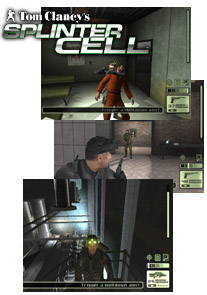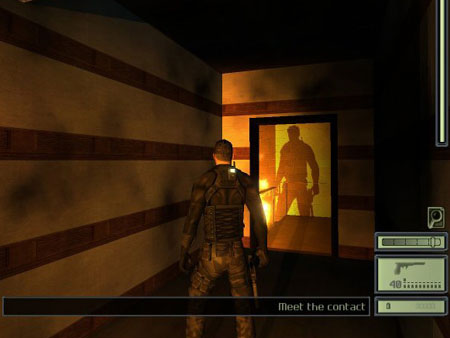Benchmarks - Splinter Cell
Splinter CellIn our Benchmark suite is the very popular game Splinter Cell. Making a believable world for a spy to play in is quite a daunting ta sk, but the levels are varied, filled with appropriate objects, and designed so that you usually dont have to choose between too many paths. It wouldve been great if you couldve had several points of entrance and that way get a lot more replay-value. Sam and the rest of the characters do look terrific, with high polygon models and both crisp and appropriate looking textures. What really separates Splinter Cell from most recent action games is the use of shadows. Splinter Cell uses the Unreal engine, which weve seen in several great looking games the past months, but UbiSoft also added improved lighting. By using real-time cast shadows, lightmaps, etc, this title gives you some of the best looking shadows to date.
sk, but the levels are varied, filled with appropriate objects, and designed so that you usually dont have to choose between too many paths. It wouldve been great if you couldve had several points of entrance and that way get a lot more replay-value. Sam and the rest of the characters do look terrific, with high polygon models and both crisp and appropriate looking textures. What really separates Splinter Cell from most recent action games is the use of shadows. Splinter Cell uses the Unreal engine, which weve seen in several great looking games the past months, but UbiSoft also added improved lighting. By using real-time cast shadows, lightmaps, etc, this title gives you some of the best looking shadows to date.
In response to the growing use of sophisticated digital encryption to conceal potential threats to the national security of the United States, the NSA (National Security Agency) has ushered forth a new dawn of intelligence-gathering techniques. This top-secret initiative is dubbed Third Echelon. Denied to exist by the U.S. government, Third Echelon deploys elite intelligence-gathering units consisting of a lone field operative supported by a remote team. Like a sliver of glass, a Splinter Cell is small, sharp, and nearly invisible.
You have the right to spy, steal, destroy and assassinate, to ensure that American freedoms are protected. If captured, the U.S. government will disavow any knowledge of your existence.
You are Sam Fisher.
You are a Splinter Cell.
Splinter Cell is a DirectX 8/9 title and can handle Pixel Shaders if your card supports it. The downside of this nice piece of software is that it has different modes for different classes of hardware. We designed a configuration that is nearly the same for all graphics cards, however any low-end graphics card that does not support Pixel Shaders will reproduce a slightly different score. Secondly Splinter Cell has two shadowing techniques, Projector and Buffer mode. We force Projector mode in high detail on all graphics cards. Again, graphics cards without shader capabilities will run into a problem as they do not support it. We are talking about GeForce4 MX and earlier models (excluding the GeForce 3 series) only. With that in mind this software really is an excellent benchmark. Small sidenote, we are not using the standard timedemo's. We made one ourselves that stresses the fillrate of a graphics card and will utilize a CPU very little.
Let's take a look at some of the benchmark numbers. Unlike some of the future games Splinter Cell doesnt use per-pixel lighting, so the framerate should be quite good even for owners of mid-end PCs.
| Splinter Cell 1.2b | 800x600 | 1024x768 | 1280x1024 | 1600x1200 |
| 6800 128 MB | 80 | 69 | 53 | 45 |
| x800Pro | 87 | 78 | 63 | 55 |
| 6800 - 405/875 | 95 | 83 | 64 | 55 |
| 6800GT | 98 | 87 | 68 | 58 |
| 6800U | 106 | 94 | 74 | 63 |
| x800XT | 105 | 99 | 81 | 71 |
Let's start off with a small explanation on how to look at the results. These are the results of the graphics card measured on the Athlon 64 3800+ test system with 1 GB Dual Channel memory. The higher a graphics card will go in resolution, the harder it'll be for it.
6800 128 MB is the Galaxy card we are testing today, 6800 - 405/875 is the card in overclocked status. x800Pro & x800XT of course refer to the Radeon x800 series. The 6800GT and 6800U refer to NVIDIA GeForce 6800 GT and Ultra.
|
The numbers (FPS = Frames Per Second) | ||||||||||||||
|
||||||||||||||
|
| ||||||||||||||
Let's go towards a heavy on the GPU game... Far Cry.

